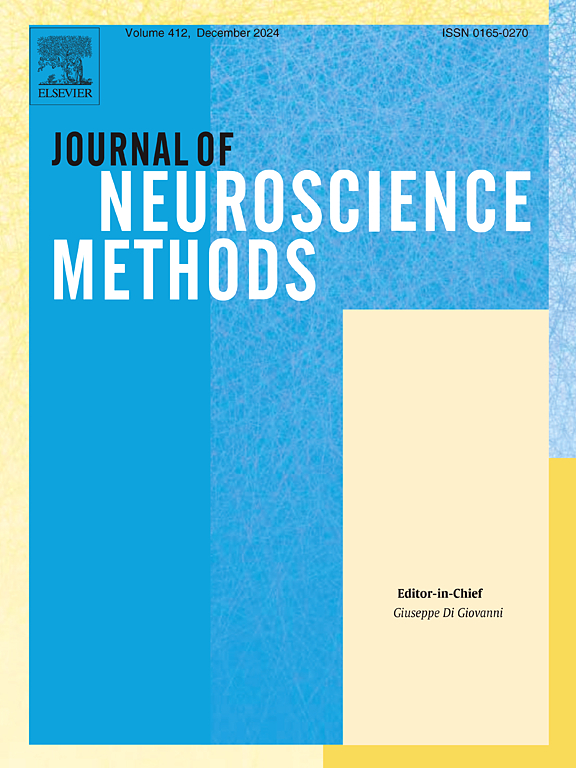改良大鼠幼崽脑脊液采集法
IF 2.3
4区 医学
Q2 BIOCHEMICAL RESEARCH METHODS
引用次数: 0
摘要
背景脑脊液(CSF)由于与脑间质直接接触,能反映大脑的生化变化,因此是临床上诊断和监测疾病进展及治疗效果的重要工具。新方法在尝试了各种已报道的方案后,我们在从幼鼠(P7-P42)中持续获得足够的 CSF 方面遇到了困难。因此,我们对这些方法进行了修改,并开发了一种每一步都具有可控和精确参数的方案,从而提高了不同研究人员之间的可重复性。结果新开发的方法实现了快速、单人操作和可重复性 CSF 提取,同时确保了高质量(415 nm 处 "质量控制溶液 "的吸光度为 0.05 AU,这是采集的 CSF 样品氧合血红蛋白污染的指标)和高产样品(P7 幼犬为 33 ± 2.128 μL,P8 幼犬为 34.10 ± 2.747 μL,P9 幼犬为 36.67 ± 3.997 μL,P10 幼犬为 36.90 ± 1.946 μL,P12 幼犬为 35.11 ± 3.285 μL,P13 幼犬为 36.90 ± 1.946 μL,P14 幼犬为 36.90 ± 1.946 μL)。与现有方法的比较与现有的大鼠幼崽 CSF 提取方法不同,我们的方案具有可重复的毛细管移液管拉管参数、可控的 CSF 质量指标,且单人操作即可在短时间内获得高产量。结论 本文对 CSF 采集过程进行了逐步比较和讨论,建立了一种单人操作即可快速、一致、充分且质量可控地采集 CSF 的方法。本文章由计算机程序翻译,如有差异,请以英文原文为准。
Modified rat pup cerebrospinal fluid collection method
Background
Cerebrospinal fluid (CSF) reflects biochemical changes in the brain due to its direct contact with brain interstitial fluid, making it a valuable tool for diagnosing and monitoring disease progression and therapeutic effectiveness in clinical practice. However, collecting CSF in animal studies, particularly from small animals like rat pups or mice, poses significant challenges.
New method
After attempting various reported protocols, we encountered difficulties in consistently obtaining sufficient CSF from rat pups (P7-P42). Consequently, we modified these methods and developed a protocol with controllable and precise parameters for each step, enhancing reproducibility across different researchers.
Results
The newly developed method enables rapid, single-operator, and reproducible CSF extraction while ensuring high-quality (the absorbance of the “quality control solution” at 415 nm < 0.05 AU, an indicator of oxyhemoglobin contamination for the collected CSF samples) and high-yield samples (33 ± 2.128 μL for P7 pups, 34.10 ± 2.747 μL for P8 pups, 36.67 ± 3.997 μL for P9 pups, 36.90 ± 1.946 μL for P10 pups, 35.11 ± 3.285 μL for P10 hypoxic-ischemic brain damage (HIBD) pups and 51.70 ± 5.256 μL for P42 pups, respectively).
Comparison with existing methods
Unlike existing methods of CSF extraction in rat pups, our protocol has reproducible capillary pipette pulling parameters, controllable CSF quality indexes, and can be operated by a single person with high yield in a short time.
Conclusions
This paper provides a step-by-step comparison and discussion of the CSF collection process, establishing a method that enables a single operator to collect CSF rapidly, consistently, sufficiently, and with controlled quality.
求助全文
通过发布文献求助,成功后即可免费获取论文全文。
去求助
来源期刊

Journal of Neuroscience Methods
医学-神经科学
CiteScore
7.10
自引率
3.30%
发文量
226
审稿时长
52 days
期刊介绍:
The Journal of Neuroscience Methods publishes papers that describe new methods that are specifically for neuroscience research conducted in invertebrates, vertebrates or in man. Major methodological improvements or important refinements of established neuroscience methods are also considered for publication. The Journal''s Scope includes all aspects of contemporary neuroscience research, including anatomical, behavioural, biochemical, cellular, computational, molecular, invasive and non-invasive imaging, optogenetic, and physiological research investigations.
 求助内容:
求助内容: 应助结果提醒方式:
应助结果提醒方式:


